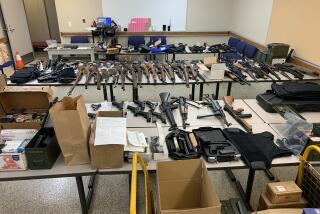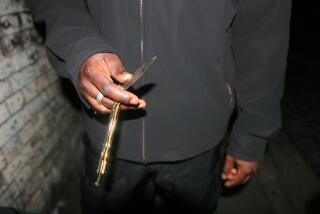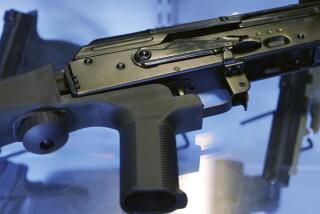Supreme Court bolsters gun owners’ right to carry a weapon in public

High court strikes down gun laws in California, New York and six other states that restrict permits to carry a concealed weapon.
The Supreme Court on Thursday upheld the rights of gun owners to carry a loaded weapon in public, ruling that the 2nd Amendment right to “bear arms” overrides laws in New York and California that restrict who may legally take guns when they leave home.
The court’s conservative majority said in a 6-3 ruling that the Constitution puts these decisions in the hands of gun owners, not with local officials, county sheriffs or others who fear that too many guns on the streets are a threat to public safety.
Writing for the court, Justice Clarence Thomas said the Constitution’s 2nd Amendment “protects an individual’s right to carry a handgun for self-defense outside the home.”
New York, like California, limits who may obtain a permit to carry a concealed weapon, but Thomas said such a restriction is unconstitutional because “it prevents law-abiding citizens with ordinary self-defense needs from exercising their right to keep and bear arms.”
The ruling casts legal doubt on some of California’s gun laws, considered among the strictest in the nation.
Now that the Supreme Court has tossed out a New York law limiting who can get a permit to carry a gun, California’s rules are on shaky legal ground.
Some — such as banning guns in certain places or situations, or restricting access to those with criminal records — aren’t likely to be affected by the ruling, which says the government’s ability to ban guns in “sensitive places” is “settled” law.
But limits on carrying weapons outside the home are expected to face legal challenge.
The ruling in New York State Rifle & Pistol Assn. vs. Bruen is the most significant victory for gun rights since 2008, when the justices for the first time ruled the 2nd Amendment protects an individual’s right to have a gun and not just states’ right to maintain a “well-regulated militia.”
The 2008 decision struck down a total ban on keeping handguns at home in Washington, D.C. A ruling two years later struck down a similar handgun ban in Chicago.
But for most of the next decade, the court turned away subsequent 2nd Amendment challenges to a variety of state and local laws, including restrictions on rapid-fire “assault” rifles.
Thursday’s decision reflects how President Trump’s three appointees shifted the court to the right. In particular, the arrival of Justices Brett M. Kavanaugh and Amy Coney Barrett created a majority to bolster the right to carry a gun.
Gun control advocates had said they feared a high court ruling upholding the right to be armed in public could lead to a massive increase in the number of guns on the streets in major cities.
But the court’s majority stressed that in 43 states, lawful gun owners may carry a firearm in public. Some require a permit, others do not.
However, six blue states require concealed-carry permits and issue them only to those who can show a “good cause” or special need to be armed.
The standards differ county by county, depending on the views of top law enforcement officials. In addition to New York and California, permits are strictly limited in Hawaii, Maryland, Massachusetts, New Jersey and the District of Columbia.
Under the court’s opinion, states like California may require permits for carrying a concealed gun, but they may not require lawful gun owners to show a special need to have such a weapon.
Thomas agreed local governments could restrict guns in or near “sensitive places,” such as schools, government buildings or polling places.
But he said the court was not likely to expand the category of gun-free zones “to all places of public congregation. ... Put simply, there is no historical basis for New York to effectively declare the island of Manhattan a ‘sensitive place’ simply because it is crowded and protected generally by the New York City Police Department.”
The decision also does not spell out how other gun restrictions may be judged, including bans on rapid-fire weapons or age limits on who may purchase such guns.
The decision comes following back-to-back mass shootings last month in Buffalo, N.Y., and Uvalde, Texas, and as Congress prepares to pass a modest bipartisan gun-violence measure, its first in three decades.
The bill, which the Senate approved Thursday, would increase background checks for would-be gun buyers ages 18 to 21, and close the “boyfriend” loophole by prohibiting anyone convicted of abuse against a spouse or domestic partner from buying a gun.
In a long dissent, Justice Stephen G. Breyer highlighted the toll of gun violence in this country.
“In 2020, 45,222 Americans were killed by firearms,” he said. “Since the start of this year, there have been 277 reported mass shootings — an average of more than one per day. Gun violence has now surpassed motor vehicle crashes as the leading cause of death among children and adolescents.”
Breyer argued states should be allowed to restrict and regulate guns to save lives.
Justice Samuel A. Alito Jr., who was part of the majority, took issue with Breyer’s comments and argued that whether an adult may carry a handgun has little to do with the wave of mass shootings. He said that the mass shooting in Buffalo cast doubt on whether New York’s restrictions on handguns were effective in preventing gun violence.
The case began when two men from upstate New York — Brandon Koch and Robert Nash — applied for a license to carry a concealed gun.
Thomas described them as law-abiding gun owners, but they were turned down. They did, however, obtain a permit to carry a hunting rifle. They then joined a lawsuit to challenge the permit restrictions.
In part of his 63-page opinion, Thomas focused on the Reconstruction era and explained how the right to bear arms was crucial for the self-protection of African Americans in the South.
He noted that Congress in 1868 “reaffirmed that freedmen were entitled to the ‘full and equal benefit of all laws and proceedings concerning personal liberty [and] personal security ... including the constitutional right to keep and bear arms.’”
Historians have also noted that the right to bear arms and create militias was also used against Black Americans, as enslaved people and during the backlash to Reconstruction.
Thomas argued for putting the 2nd Amendment on the same footing as the 1st Amendment’s right to free speech.
“The constitutional right to bear arms in public for self defense is not ‘a second-class right, subject to an entirely different body of rules than the other Bill of Rights guarantees,’” he wrote.
Wayne LaPierre, executive vice president of the National Rifle Assn., called the ruling “another landmark win for constitutional freedom. Decades of right-to-carry laws all across America have proven that good men and women are not the problem.”
Sen. Chris Coons (D-Del.) condemned both the decision and its timing.
“On a day when the U.S. Senate is about to pass historic, bipartisan gun safety legislation that will save lives, the current Supreme Court has issued a decision that will likely put more lives at risk. Today’s court is led by conservative judicial activists who twist constitutional analysis to substitute their own policy preferences for laws passed by Congress or the states,” he said.
New York Gov. Kathy Hochul said in a statement that “it is outrageous that at a moment of national reckoning on gun violence, the Supreme Court has recklessly struck down a New York law that limits those who can carry concealed weapons.”
Times staff writer Jon Healey in Los Angeles contributed to this report.
More to Read
Get the L.A. Times Politics newsletter
Deeply reported insights into legislation, politics and policy from Sacramento, Washington and beyond. In your inbox three times per week.
You may occasionally receive promotional content from the Los Angeles Times.








